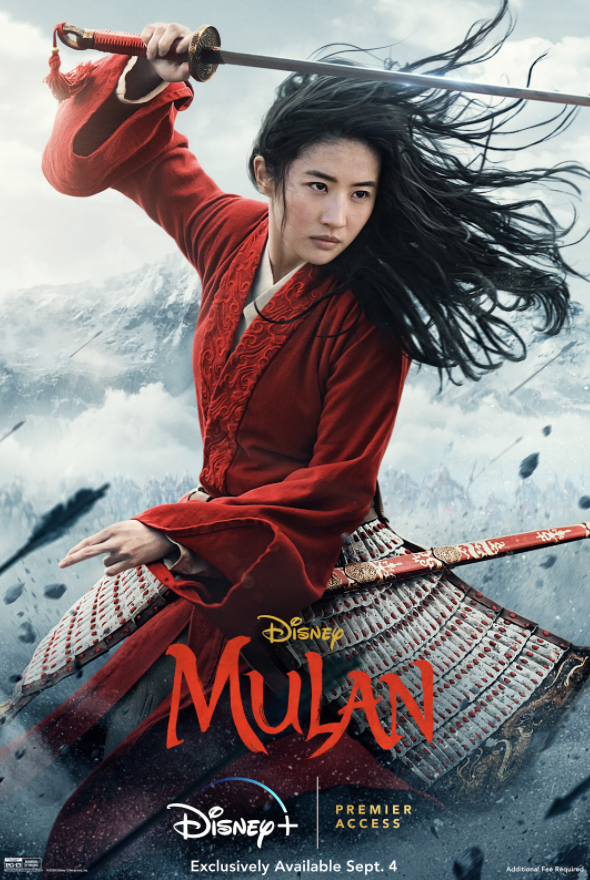Mulan (2020) — Live-Action Adaptation of a Disney Favorite Raises Questions About Cultural Representation in Hollywood
October 2, 2020
The announcement of the release of the new live-action film, Mulan, was met with a wave of controversy. This movie was to be a live depiction of the family favorite Disney animation Mulan (1998), and was highly anticipated. However, it was soon deemed to be very problematic. The first disputes came with the rumors of casting a white leading actress as Mulan. These rumors died down after Disney announced that Liu Yifei, a prominent Chinese actor with roots in Queens, NY, would play the beloved Disney character. However, it was immediately followed by outrage and calls to boycott the film due to Yifei’s support of the Hong Kong police. When the movie was released, the credits contained eight government entities that are involved with the Uighur internment camps in China, which caused major backlash, leading to the creation of #BoycottMulan. The live-action adaptation of Mulan was anticipated to not only bring a classic animation to life, but also bring representation to the Asian community in Hollywood. However, it became apparent that this new version could not satisfy the audience’s demand. Mulan has not succeeded as originally projected. The movie’s budget was over $200 million, but the box office came in at approximately $58.3 million. In addition to the widely publicized #BoycottMulan controversy, there is another issue that poses an important question: How can a movie be culturally accurate if the writers and creative staff are not immersed in the culture? Mulan has been largely criticized for its fully non-Asian team of directors and creative staff. From the wardrobe all the way to the screenplay, Mulan was arranged by people who are not connected to Chinese culture. Though they had Chinese advisors, it has been proven that the live-action Mulan may just be a Chinese story told through the Western lens, accompanied by previous Hollywood prejudices.
The accuracy of the storyline and details of Mulan demonstrate Hollywood’s outdated and stereotypical understanding of the Asian community and Chinese culture. The creative team gave the impression that historical correctness was not considered throughout the creation of this film, which is evident in the Emperor’s costume and physical appearance. Jet Li, who played the Emperor in Mulan, was portrayed in a manner very similar to Fu Manzhou (a fictional villain written by Sax Rohmer more than 100 years ago), who represents Western stereotypes of the Chinese, and perpetuates the old ideology of the “yellow peril.” Fu Manzhou’s character contributed to the rise of anti-Chinese sentiments during the 20th century, with Manzhou portrayed as a scheming emperor, plotting domination over the West. The Mulan Emperor’s appearance heavily diverged from accurate Chinese tradition, and a simple google search would allow one to see the traditional style and fashion Emperors in ancient China were adorned with. This has led many fans to believe that the false depiction of the Emperor is deliberate.
Many have questioned whether Western film producers and writers would be able to understand the deep roots of loyalty and filial piety that is at the core of Chinese culture. Mulan proved they could not. The original Ballad of Mulan is written about a girl named Hua Mulan who went to war for her injured father. Mulan sacrificed herself for the benefit of the country, and the collective. She joined the army for her father, gave up her way of life, galloped onto the battlefield, defended the country, and fought for 10 long years before she returned home. The live-action version seems to have a different spiritual core. This adaptation depicts Mulan as a rebellious girl who rejects traditional culture, secretly practices martial arts, and resists arranged marriages, which does not match up with traditional Chinese themes. The movie is told strictly from a Western lens, disregarding the realities of conventional Chinese culture.
Not only are Chinese netizens unhappy with Mulan, but the announcement of the reboot led to widespread anticipation, as people waited to see their favorite characters come to life. Much to the dismay of the general public, many characters did not make a debut in the live-action version. These characters included Mushu, Mulan’s feisty red dragon companion, and Li Shang, Mulan’s love interest. Classic Disney songs from the original soundtrack also failed to appear, with the exception of an orchestral medley including Reflection and Honor Us All. The remake detracted from the essence of the animated Mulan, which includes music and beloved characters. The live-action version also added new characters to an already altered storyline. Unlike other live-action reboots of Disney cartoons, such as The Lion King and Aladdin, the storyline of Mulan has been completely transformed.
The goal of the original Mulan was to show that a regular woman could be just as strong and brave as men. In the original version, Mulan was not a “superwoman”, as portrayed in the reboot, where she was armed with “Chi ” that made her fit to fight. The original message was that a regular woman can do the same as men. This message is clearly missing from the live-action reboot.
The release of Mulan has been met with outrage around the world. Many are upset about oppressive government organizations were credited and the lead actress supported the Hong Kong Police. As a whole, the movie raises questions about whether Hollywood is actually including accurate representations of different cultures, and whether old stereotypes are still being perpetuated in such movies. Mulan walks the line of being classified as cultural output, or failed representation of Chinese culture, therefore undermining the power of cultural interpretation.



